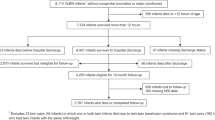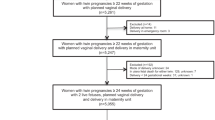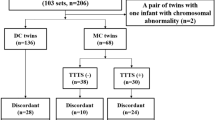Abstract
Objective:
We compared perinatal mortality, preterm birth (<37, <33 and <28 weeks), small for gestational age (SGA), Apgar score (<4), mechanical ventilation (⩾1 days) and prolonged neonatal intensive care unit (NICU) hospitalization (⩾13 days) between twins of 25 to 34 and >35-year-old women. Further, we examined whether older maternal age effects were modified by parity or otherwise affected by chorionicity.
Study Design:
We carried out a population-based retrospective cohort study including all twin births in British Columbia (BC), Canada, from 1999 to 2003. The BC perinatal database registry was used to obtain clinical, behavioral and demographic data. Adjusted odds ratios (OR) with 95% confidence intervals (CI) were calculated using generalized estimating equation models.
Result:
Overall, twins of older women were more likely to be born preterm (<37 weeks), but not very or extremely preterm (<33 weeks). These twins were not at increased risk of perinatal death, mechanical ventilation or were not SGA compared with twins of younger women. Twins of older primiparous women did not have an elevated risk of NICU hospitalization; twins born to older multiparous women had higher risk (OR=1.8; 95% CI: 1.2 to 2.6). Analyses restricted to opposite-sex (dichorionic) twins showed that perinatal death, mechanical ventilation and very preterm birth occur less likely among older women (OR=0.2 (95% CI: 0.0 to 0.8), OR=0.3 (95% CI: 0.1 to 0.7) and OR=0.4 (95% CI: 0.2 to 0.7), respectively). Further, the risk of late preterm birth was increased and NICU hospitalization was reduced among opposite-sex twins born to older compared with younger primiparous women (OR=1.9 (95% CI: 1.3 to 2.8) and OR=0.2 (95% CI: 0.1 to 0.5), respectively).
Conclusion:
Twins of older mothers did not have an elevated risk for most adverse birth outcomes, except for late preterm birth. Risks of neonatal care admission may be elevated among older multiparous women.
This is a preview of subscription content, access via your institution
Access options
Subscribe to this journal
Receive 12 print issues and online access
$259.00 per year
only $21.58 per issue
Buy this article
- Purchase on Springer Link
- Instant access to full article PDF
Prices may be subject to local taxes which are calculated during checkout
Similar content being viewed by others
References
Ananth CV, Joseph KS, Demissie K, Vintzileos AM . Trends in twin preterm birth subtypes in the United States, 1989 through 2000: impact on perinatal mortality. Am J Obstet Gynecol 2005; 193: 1076–1082.
Joseph KS, Marcoux S, Ohlsson A, Liu S, Allen AC, Kramer MS et al. Changes in stillbirth and infant mortality associated with increases in preterm birth among twins. Pediatrics 2001; 108: 1055–1061.
Joseph KS, Allen AC, Dodds L, Vincer MJ, Armson BA . Causes and consequences of recent increases in preterm birth among twins. Obstet Gynecol 2001; 98: 57–64.
Blondel B, Kaminski M . Trends in the occurrence, determinants, and consequences of multiple births. Semin Perinatol 2002; 26: 239–249.
Blickstein I, Keith LG . Multiple gestations. Obstet Gynecol Clin North Am 2005; 32: xiii–xxiv.
Martin JA, Hamilton BE, Sutton PD, Ventura SJ . Births; Final data for 2006 2009 National Vital Statistics Reports. No. 7, vol. 57. National Centre for Health Statistics: Hyattsville, MD.
Tough SC, Greene CA, Svenson LW, Belik J . Effects of in vitro fertilization on low birth weight, preterm delivery, and multiple birth. J Pediatr 2000; 136: 618–622.
Bissonnette F, Cohen J, Collins J, Cowan L, Dale S, Dill S et al. Incidence and complications of multiple gestation in Canada: proceedings of an expert meeting. Reprod Biomed Online 2007; 14: 773–790.
The multiple birth foundation, media inquiries, general information. http://www.multiplebirths.org.uk/media.aspAccessed on December 2008.
Westergaard T, Wohlfahrt J, Aaby P, Melbye M . Population based study of rates of multiple pregnancies in Denmark, 1980–94. BMJ 2008; 314: 775–786.
Steegers-Theunissen RP, Zwertbroek WM, Huisjes AJ, Kanhai HH, Bruinse HW, Merkus HM . Multiple birth prevalence in The Netherlands. Impact of maternal age and assisted reproductive techniques. J Reprod Med 1998; 43: 173–179.
Prapas N, Kalogiannidis I, Prapas I, Xiromeritis P, Karagiannidis A, Makedos G . Twin gestation in older women: antepartum, intrapartum complications, and perinatal outcomes. Arch Gynecol Obstet 2005; 273 (5): 293–297.
Zhang J, Meikle S, Grainger DA, Trumble A . Multifetal pregnancy in older women and perinatal outcomes. Fertil Steril 2002; 78: 562–568.
Delbaere I, Verstraelen H, Goetgeluk S, Martens G, Derom C, De Bacquer D et al. Perinatal outcome of twin pregnancies in women of advanced age. Hum Reprod 2008; 23: 2145–2150.
Luke B, Brown MB . Contemporary risks of maternal morbidity and adverse outcomes with increasing maternal age and plurality. Fertil Steril 2007; 88: 283–293.
Misra DP, Ananth CV . Infant mortality among singletons and twins in the United States during 2 decades: effects of maternal age. Pediatrics 2002; 110: 1163–1168.
Branum AM, Schoendorf KC . The influence of maternal age on very preterm birth of twins: differential effects by parity. Paediatr Perinat Epidemiol 2005; 19: 399–404.
Lee Shoo K . Levels of neonatal care. Paediatr Child Care 2006; 11 (5): 303–306.
McMillan DD, Chan HWP, Lee SK . Canadian Neonatal Network Report 1996–1997, vol. 1, CNN: Vancouver, BC, Canada.
Synnes AR, Ling EW, Whitfield MF, Mackinnon M, Lopes L, Wong G et al. Perinatal outcomes of a large cohort of extremely low gestational age infants (twenty-three to twenty-eight completed weeks of gestation). J Pediatr 1994; 125: 952–960.
Alexander GR, Kogan M, Martin J, Papiernik E . What are the fetal growth patterns of singletons, twins, and triplets in the United States? Clin Obstet Gynecol 1998; 41: 114–125.
Joseph KS, Allen AC, Dodds L, Turner LA, Scott H, Liston R . The perinatal effects of delayed childbearing. Obstet Gynecol 2005; 105: 1410–1418.
Cnattingius S, Forman MR, Berendes HW, Isotalo L . Delayed childbearing and risk of adverse perinatal outcome. A population-based study. JAMA 1992; 268: 886–890.
Oleszczuk JJ, Keith LG, Oleszczuk AK . The paradox of old maternal age in multiple pregnancies. Obstet Gynecol Clin North Am 2005; 32: 69–80, ix.
Pinborg A, Lidegaard O, Andersen AN . The vanishing twin: a major determinant of infant outcome in IVF singleton births. Br J Hosp Med (Lond) 2006; 67: 417–420.
Pinborg A, Lidegaard O, Freiesleben NC, Andersen AN . Vanishing twins: a predictor of small-for-gestational age in IVF singletons. Hum Reprod 2007; 22: 2707–2714.
Adashek JA, Peaceman AM, Lopez-Zeno JA, Minogue JP, Socol ML . Factors contributing to the increased cesarean birth rate in older parturient women. Am J Obstet Gynecol 1993; 169: 936–940.
Breslow NE, Day NE . Statistical Methods in Cancer Research: Vol. I—The Analysis of Case-Control Studies. IARC: Lyon, 1980, Scientific Publication no 32.
Platt MJ, Pharoah PO . The epidemiology of sudden infant death syndrome. Arch Dis Child 2003; 88: 27–29.
Pharoah PO, Platt MJ . Sudden infant death syndrome in twins and singletons. Twin Res Hum Genet 2007; 10 (4): 644–648.
Acknowledgements
Sarka Lisonkova was supported by the Western Regional Training Centre for Health Services Research, the Michael Smith Foundation for Health Research and the Canadian Institutes for Health Research through a graduate and senior graduate scholarship. We thank the BC Perinatal Health Program for access to the data.
Author information
Authors and Affiliations
Corresponding author
Ethics declarations
Competing interests
The authors declare no conflict of interest.
Appendix
Appendix
Rights and permissions
About this article
Cite this article
Lisonkova, S., Sheps, S., Janssen, P. et al. Effect of older maternal age on birth outcomes in twin pregnancies: a population-based study. J Perinatol 31, 85–91 (2011). https://doi.org/10.1038/jp.2010.114
Received:
Revised:
Accepted:
Published:
Issue Date:
DOI: https://doi.org/10.1038/jp.2010.114
Keywords
This article is cited by
-
Rural–urban disparities in caesarean deliveries in sub-Saharan Africa: a multivariate non-linear decomposition modelling of Demographic and Health Survey data
BMC Pregnancy and Childbirth (2022)
-
Very advanced maternal age and morbidity in Victoria, Australia: a population based study
BMC Pregnancy and Childbirth (2013)



